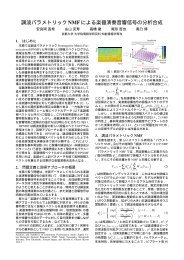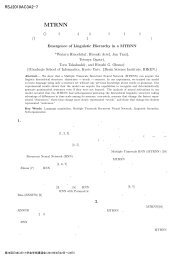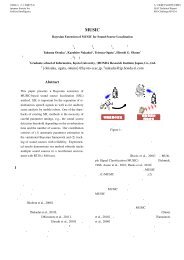., SIMO-ICA , SIMO tele-presence 4.3 Sound Demonstrations SIMO-ICA WEB .http://www.aist-nara.ac.jp/~tomoya-t/demo_index.html, , .5 ConclusionSIMO-ICA tele-presence SIMO-ICA , SIMO ICA . , HATS. SIMO-ICA , SIMO-ICA [1] P. Comon, “Independent component analysis, a newconcept?,” Signal Processing, vol.36, pp.287–314,1994.[2] P. Smaragdis, “Blind separation of convolved mixturesin the frequency domain,” Neurocomputing,vol.22, pp.21–34, 1998.[3] H. Saruwatari, T. Kawamura, and K. Shikano,“Blind source separation for speech based on fastconvergencealgorithm with ICA and beamforming,”Proc. of Eurospeech, pp.2603–2606, Sept.2001.[4] A. Cichocki and S. Amari, Adaptive Blind Signaland Image Processing: Learning Algorithms andApplications, John Wiley & Sons, Ltd, West Sussex,2002.[5] J. Blauert, Spatial Hearing (revised ed.), Cambridge,MA: The MIT Press, 1997.[6] Y. Tatekura, H. Saruwatari, and K. Shikano,“Sound reproduction system including adaptivecompensation of temperature fluctuation effect forbroad-band sound control,” IEICE Trans. Fundamentals,vol.E85–A, no.8, pp.1851–1860, Aug. 2002.[7] I. Toshima, H. Uematsu, T. Hirahara, “A steerabledummy head that tracks three-dimensionalhead movement: TeleHead,” Acoustical Science andTechnology, vol.24, no.5, pp.327–329, 2003.[8] S. Tachi, K. Komoriya, K. Sawada, T. Nishiyama,T. Itoko, M. Kobayashi and K. Inoue, “Telexistencecockpit for humanoid robot control,” AdvancedRobotics, vol.17, no.3, pp.199–217, 2003.[9] T. Takatani, T. Nishikawa, H. Saruwatari, K.Shikano, “High-fidelity blind separation of acousticsignals using SIMO-model-based Independentcomponent analysis,” IEICE Trans. Fundamentas,vol.E87–A, no.8, pp.2063–2072, 2004.[10] T. Takatani, T. Nishikawa, H. Saruwatari, K.Shikano, “High-fidelity blind source separationof acoustic signals using SIMO-model-based ICAwith information-geometric learning,” Proc. ofIWAENC, pp.251–254, 2003.[11] T. Takatani, T. Nishikawa, H. Saruwatari, K.Shikano, “”Comparison between SIMO-ICA withleast squares criterion and SIMO-ICA withinformation-geometric learning,” Proc. of InternationalCongress on Acoustics, pp.I-329–332, 2004.[12] T. Takatani, S. Ukai, T. Nishikawa, H. Saruwatari,K. Shikano, “Evaluation of simo separation methodsfor blind decomposition of binaural mixed signals,”Proc. of IWAENC, pp.233–236, 2005.[13] H. Saruwatari, H. Yamajo, T. Takatani, T.Nishikawa, K. Shikano, “Blind separation anddeconvolution for convolutive mixture of speechcombining SIMO-model-based ICAand multichannelinverse filtering,” IEICE Trans. Fundamentas,vol.E88–A, no.9, pp.2387–2400, 2004.[14] H.Saruwatari,S.Ukai,T.Takatani,T.Nishikawa,K. Shikano, “Two-stage blind source separationcombining SIMO-model-based ICA and adaptivebeamforming,” Proc. of EUSIPCO, TueAmPO2,2005.14
[15] Y. Mori, H. Saruwatari, T. Takatani, S. Ukai, K.Shikano, T. Hiekata T. Morita “Real-time implementationof two-stage blind sources separationcombining SIMO-ICA and binary masking,” Proc.of IWAENC, pp.229–232, 2005.[16] S. Choi, S. Amari, A. Cichocki, and R. Liu, “Naturalgradient learning with a nonholonomic constraintfor blind deconvolution of multiple channels,”Proc. of International Workshop on ICA andBSS, pp.371–376, Jan. 1999.[17] K. Matsuoka and S. Nakashima, “Minimal distortionprinciple for blind source separation,” Proc. ofInternational Conference on ICA and BSS, pp.722–727, Dec. 2001.[18] N. Murata and S. Ikeda, “An on-line algorithm forblind source separation on speech signals,” Proc. of1998 International Symposium on Nonlinear Theoryand its Application (NOLTA), vol.3, pp.923–926, Sep. 1998.[19] T. Nishikawa, H. Saruwatari, and K. Shikano,“Stable learning algorithm for blind separationof temporally correlated acoustic signals combiningmultistage ICA and linear prediction,” IEICETrans. Fundamentals, vol.E86-A, no.8, pp.2028–2036, 2003.[20] H. Saruwatari, H. Yamajo, T. Takatani, T.Nishikawa, and K. Shikano, “Blind separation anddeconvolution of MIMO-FIR system with coloredsound inputs using SIMO-model-based ICA”, Proc.IEEE Workshop on SSP, pp.421–424, Sept. 2003.[21] C. Simon, P. Loubaton, C. Vignat, C. Jutten, G.d’Urso, “Separation of a class of convolutive mixturesacontrat: a contrast function approach,” Proc.of ICASSP, 1429–1432, March 1999.[22] J.K. Tugnait, “Identification and deconvolution ofmultichannel linear non-gaussian processes usinghigher order statistics and inverse filter criteria,”IEEE trans. on signal processing, Vol. 45. pp 658–672, 1997.[23] N. Charkani, and Y. Deville, “A convolutive separationmethod with self-optimizing non-linearities,”Proc. of ICASSP, pp.2909–2912, Mar. 1999.[24] J.-F. Cardoso, “Multidimensional independentcomponent analysis,” Proc. of ICASSP, vol. 4,pp.1941–1944, May 1998.15
- Page 4: SCOT(Smoothed Coherence Transform)P
- Page 8 and 9: Particle (a)(b)φ12(τ )[14]x ( t )
- Page 10 and 11: - 8 -
- Page 12 and 13: 1 () 2 SIMO-ICA 3 SIMO-ICA tele
- Page 14: ICAy FCy FCy SIMO-ICAs 1(t)x 1(t)1(
- Page 19 and 20: 社 団 法 人 人 工 知 能 学
- Page 21 and 22: • 音 源 位 置マイク配 置
- Page 23 and 24: Table 1: 6 : SIR (dB)SIR 1 SIR 2 S
- Page 25 and 26: 社 団 法 人 人 工 知 能 学
- Page 27 and 28: SIMO-ICA SIMO Figure 2(a)SIMO-ICA
- Page 29 and 30: Binary maskConventional ICAConventi
- Page 31 and 32: 社 団 法 人 人 工 知 能 学
- Page 33 and 34: k lo (l), k c (l), k hi (l) l k c
- Page 35 and 36: 5.75 m4.33 mNoise1.15 mUser 40°2.1
- Page 38 and 39: おける 方 法 論 に 関 し
- Page 40 and 41: Fig.6 は 幼 児 の ABR (Auditory
- Page 42 and 43: ンターフェースはスパイ
- Page 44 and 45: マイクロホン[ 正 面 ][ 左
- Page 46 and 47: s(k)Crosstalkn(k)R S(k)X P(k)X R(k)
- Page 48 and 49: する 隠 れマルコフモデル
- Page 50 and 51: 123ÙÖ ½ ¾º¾ ´º ½µ ´º
- Page 52 and 53: ÌÐ ½ ¿º¾ ÅÎÆÇÂ
- Page 54 and 55: ÁÒØÖÒØÓÒÐ ÓÒÖÒ ÓÒ Á
- Page 56 and 57: 例 えば、 同 一 時 間 差
- Page 58 and 59: いて、θの 絶 対 値 が 大
- Page 60 and 61: Fig.11 にこのシステムの 処
- Page 62 and 63: 5 , 2 EMIEWFig.1 EMIEW EMIEW 6 ,
- Page 64: 0 P th , (14) 4.4 3 4 4 1 , 3
- Page 67 and 68:
社 団 法 人 人 工 知 能 学
- Page 69 and 70:
3.1. 3.2. Fig. 3. The
- Page 71 and 72:
4.1. Fig. 5. The time co
- Page 73 and 74:
社 団 法 人 人 工 知 能 学
- Page 75 and 76:
modal (m, ), whispery (w, ), aspir
- Page 77 and 78:
Aperiodicity rate (APR)TLR (Time-La
- Page 79 and 80:
社 団 法 人 人 工 知 能 学
- Page 81 and 82:
, À, WDS-BF Ñ À℄·
- Page 83 and 84:
Table 1: Localization Error of A Si
- Page 85 and 86:
社 団 法 人 人 工 知 能 学
- Page 87 and 88:
を 行 い, 閾 値 処 理 を
- Page 89 and 90:
4. 音 声 対 話 制 御 実 験H
- Page 91 and 92:
社 団 法 人 人 工 知 能 学
- Page 93 and 94:
3 HLDAMLLR [3] (Useful Information
- Page 95 and 96:
Class 10degClass 20degClass 10degCl
- Page 97 and 98:
社 団 法 人 人 工 知 能 学
- Page 99 and 100:
赤 い 長 方 形 内 ). 以 下
- Page 101 and 102:
5.2 音 場 計 測 結 果(dB SPL)
- Page 103 and 104:
社 団 法 人 人 工 知 能 学
- Page 105 and 106:
a) 90 b) 90 MFMc) d) MFMe) 9
- Page 107 and 108:
(3) MFT Julius 7.1 Figure 4: SIG2
















